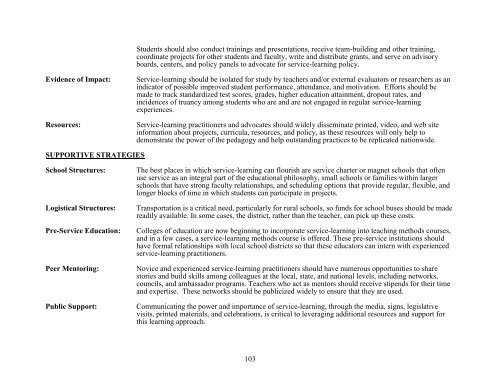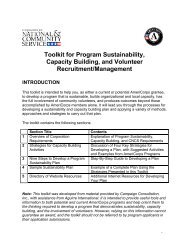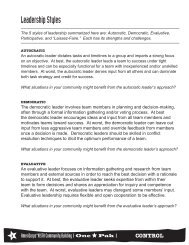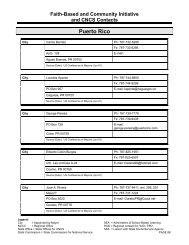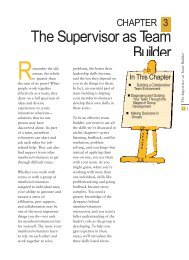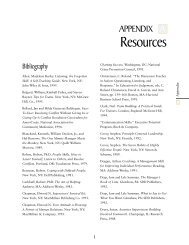MAKE IT LAST FOREVER: THE ... - National Service Resource Center
MAKE IT LAST FOREVER: THE ... - National Service Resource Center
MAKE IT LAST FOREVER: THE ... - National Service Resource Center
Create successful ePaper yourself
Turn your PDF publications into a flip-book with our unique Google optimized e-Paper software.
Evidence of Impact:<br />
<strong>Resource</strong>s:<br />
SUPPORTIVE STRATEGIES<br />
School Structures:<br />
Logistical Structures:<br />
Pre-<strong>Service</strong> Education:<br />
Peer Mentoring:<br />
Public Support:<br />
Students should also conduct trainings and presentations, receive team-building and other training,<br />
coordinate projects for other students and faculty, write and distribute grants, and serve on advisory<br />
boards, centers, and policy panels to advocate for service-learning policy.<br />
<strong>Service</strong>-learning should be isolated for study by teachers and/or external evaluators or researchers as an<br />
indicator of possible improved student performance, attendance, and motivation. Efforts should be<br />
made to track standardized test scores, grades, higher education attainment, dropout rates, and<br />
incidences of truancy among students who are and are not engaged in regular service-learning<br />
experiences.<br />
<strong>Service</strong>-learning practitioners and advocates should widely disseminate printed, video, and web site<br />
information about projects, curricula, resources, and policy, as these resources will only help to<br />
demonstrate the power of the pedagogy and help outstanding practices to be replicated nationwide.<br />
The best places in which service-learning can flourish are service charter or magnet schools that often<br />
use service as an integral part of the educational philosophy, small schools or families within larger<br />
schools that have strong faculty relationships, and scheduling options that provide regular, flexible, and<br />
longer blocks of time in which students can participate in projects.<br />
Transportation is a critical need, particularly for rural schools, so funds for school buses should be made<br />
readily available. In some cases, the district, rather than the teacher, can pick up these costs.<br />
Colleges of education are now beginning to incorporate service-learning into teaching methods courses,<br />
and in a few cases, a service-learning methods course is offered. These pre-service institutions should<br />
have formal relationships with local school districts so that these educators can intern with experienced<br />
service-learning practitioners.<br />
Novice and experienced service-learning practitioners should have numerous opportunities to share<br />
stories and build skills among colleagues at the local, state, and national levels, including networks,<br />
councils, and ambassador programs. Teachers who act as mentors should receive stipends for their time<br />
and expertise. These networks should be publicized widely to ensure that they are used.<br />
Communicating the power and importance of service-learning, through the media, signs, legislative<br />
visits, printed materials, and celebrations, is critical to leveraging additional resources and support for<br />
this learning approach.<br />
103


